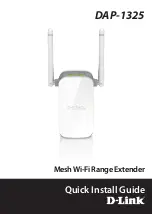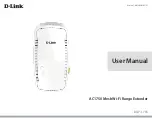
3
D-Link DAP-1610 User Manual
Section 1 - Product Overview
Introduction
Features
Easily Extend Your Existing Network
The DAP-1610 AC1200 Wi-Fi Range Extender lets you easily extend a secure wireless network with a press of a button. Connect the
DAP-1610 to a router via Wi-Fi or Ethernet and share your high-speed Internet access in more places throughout your home or small
office.
High-speed Wireless Performance With Wireless 802.11ac Technology
Thanks to the latest Wireless AC technology, the DAP-1610 provides a wireless connection at up to 1200 Mbps* with other 802.11ac
wireless devices. This feature lets you participate in real-time activities online, such as video streaming, online gaming, and real-time
audio with smooth performance.
Simple Setup
All it takes is a press of a button to connect compatible WPS devices to the DAP-1610. Its easy-to-use web interface lets you quickly
and easily connect the DAP-1610 to an uplink router, configure the extended wireless network, and manage the administrative
settings. The setup wizard will even guide you through the setup process, getting your extended wireless network up and running
in no time. Alternatively, connect an Ethernet cable to your existing network infrastructure to quickly and easily create a wireless
network.
Compatibility
The DAP-1610 is fully compatible with now only the latest 802.11ac standard, but is also backwards compatible with IEEE 802.11n/g/
b/a wireless devices, so you can use your existing devices without sacrificing performance.
Latest Wireless Network Security and Encryption
The DAP-1610 supports wireless security features to prevent unauthorized access from the wireless network. Support for WPA/
WPA2 standards ensure that you’ll be able to use the best possible encryption methods with your compatible wireless devices.
* Maximum wireless signal rate derived from standard IEEE specifications. Actual data throughput will vary. Network conditions and environmental factors, including volume
of network traffic, building materials and construction, and network overhead may lower actual data throughput rate. Environmental conditions will adversely affect wireless
signal range.








































